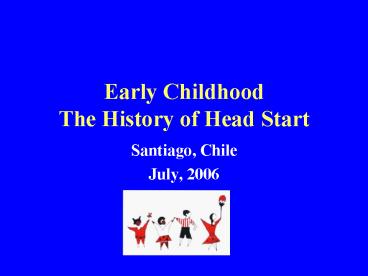Early Childhood The History of Head Start - PowerPoint PPT Presentation
1 / 30
Title:
Early Childhood The History of Head Start
Description:
To improve the well-being of all our children, we need to integrate educational, ... Percentage of 6th-12th graders with high risk behaviors, by number of assets ... – PowerPoint PPT presentation
Number of Views:730
Avg rating:3.0/5.0
Title: Early Childhood The History of Head Start
1
Early ChildhoodThe History of Head Start
- Santiago, Chile
- July, 2006
2
Propositions
- To improve the well-being of all our children, we
need to integrate educational, medical public
health approaches - We have models for doing this
- What stands in our way are
- - Inadequate political will
- - Incompletely developed social strategies
3
21st Century Community Factors that Affect Child
Wellbeing
- Poverty
- Ethnicity
- Geography
- Environment
- Family configuration
- Parental occupation
- Stress
- Isolation
4
Outcomes
- Violence
- Child Abuse
- Homelessness
- Hunger
- Depression
- Suicide
- Drug/alcohol
- HIV/AIDS
5
Percentage of 6th-12th graders with high risk
behaviors, by number of assetsfrom Benson,
Leffert, Scales, Blyth (n99,462)
Source Benson et al.
6
Richmond Model
- Knowledge Base
- Statistics
- Best Practices
- Social Strategy
- Macro
- Micro
- Political Will
7
(No Transcript)
8
(No Transcript)
9
(No Transcript)
10
(No Transcript)
11
(No Transcript)
12
(No Transcript)
13
FROM CRADLE TO CLASSROOM HEAD START EARLY
HEAD START
- Catherine Ayoub
- Santiago, Chile
- July, 2006
14
What is Head Start Now?
15
Head Start (1964)3-6 year oldscomprehensivece
nter-based Early Head Start (1995) birth to 3
year oldscomprehensivehome, center or mixed base
16
Early Head Start Head Start Are Intensive,
Two-Generation Programs
Child Development Learning
Self-Sufficiency Healthy Families
Parenting
17
Facts About Early Head Start/Head Start Programs
- Head Start Over 19,800 programs serving about
907,000 children - Early Head Start Over 650 programs serving about
62,000 children - Children living in poverty
- 12.5 of children in Head Start are children with
disabilities
18
Grants for Program Operationfor Early Head
Start/Head Start Programs
- Federal Local
- Public Agencies
- Private Organizations
- Indian Tribes
- School Systems
19
Head Start Performance Standards Four
Cornerstones
- Child Parent
- Staff Community
20
Implications for Programs From Head Start the
Early Head Start Research Evaluation
21
The Early Head Start Research1995-2009
- 17 Early Head Start programs
- 3,001 children families
- Evaluation at 14, 24, 36 months, 4.5 years, 5th
grade. - Used random assignmentprogram control group
- National evaluator Mathematica Policy Research
- Local researchers 15 Universities
- Programs chose research partners
22
Early Head Start Research Sites
23
Positive Impacts Multiple Dimensions of
Childrens Development
- Health
- More often have current immunizations
- Fewer emergency room visits for accidents and
injuries
Cognitive
- Smaller percent with Mental Development Index lt
85 - Higher Average Bayley Mental Development Index
24
Positive Impacts Multiple Dimensions of
Childrens Development
- Language
- Larger receptive vocabularies
- Smaller percent with language delay (PPVT lt 85)
Social-emotional development
- Lower levels of aggressive behavior
- Higher sustained attention with objects
- Greater engagement of parent with child
- Child shows less negativity toward parent
25
Positive Impacts in Parenting
- Greater warmth and supportiveness
- Less detachment
- More parent-child play
- More stimulating home environments
- More support for language and learning
- More daily reading
- Less spanking by both mothers and fathers
26
EHS Benefited Some Groups That Have Been Hard to
Serve
- Teen parents
- Parents at risk for depression aat enrollment
27
Theory of Change for Head Start Professionals
- Knowledge Meaning Skill
- Training Reflection Action
28
Skills for Teaching (FACES)
- Child development knowledge
- Cognitive, Social, Emotional, Physical
- Normal Atypical
- Parent child relationships
- Solid curriculum measurement of progress
- Role models support for learning
- Perspective taking reflective practice
29
Continuous Service Improvement
- Staff continuing education
- Curriculum standards assessment
- Practical use of evaluation instruments
- Feedback to programs on strengths obstacles to
quality
30
Develop a Program
- Comprehensive
- Two Generational
- Whole child
- Parent involvement
- Uniform standards
- Staff support training
- Tried curriculum
- Community involvement
- Evaluation (CPI)































